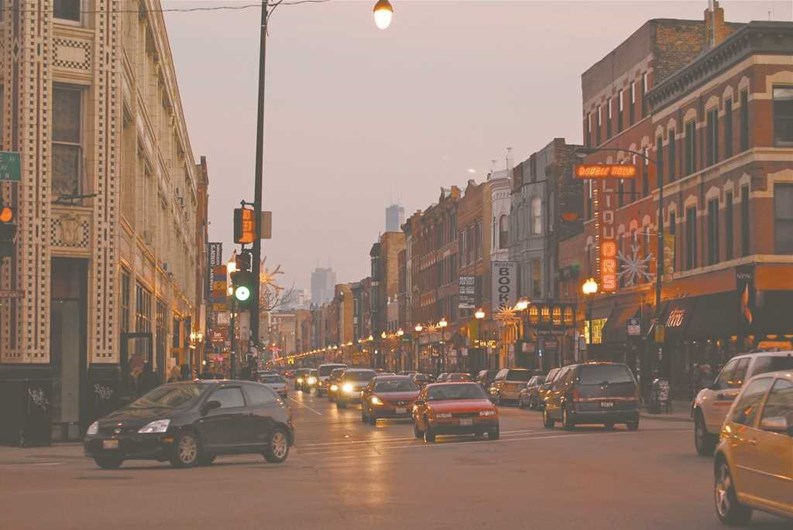When Mrs. O’Leary’s cow supposedly in a fictional account set off the great conflagration that became known as the Great Chicago Fire in 1871, an area subdivision known as Wicker Park attracted large numbers of Polish immigrants looking for a familiar place to call home.
Wicker Park is a Chicago neighborhood northwest of the Loop, south of Bucktown and west of Pulaski Park within West Town. It came into being when namesakes Charles and Joel Wicker purchased 80 acres of land along Milwaukee Avenue in 1870 and laid out a subdivision with a mix of lot sizes surrounding a 4-acre park. The fire seemingly spawned the first wave of development, as homeless Chicagoans looked to build new homes.
Wicker Park bears Chicago's creative soul. Strolling through this eccentric neighborhood just northwest of the Loop and south of Bucktown, it is no wonder that many refer to it as the beating heart of Chicago. Art galleries, boutiques, restaurants are sandwiched between cafes, nightclubs and theaters. Once heavily populated by Eastern Europeans and Scandinavians, Wicker Park is now an increasingly diverse neighborhood bearing the works and craft of local residents who work and play in this bustling community.
Beer and Brats
Wicker Park has been part of Chicago since 1837 and like many neighborhoods, its commercial beginnings were rooted in industry. In 1857, the Rolling Mill Steel Works opened near Armitage and Ashland, drawing many Irish immigrant laborers. Clothing, furniture, musical instrument, cigar manufacturers and breweries, to name a few, would eventually add to the industrial scene.
Wicker Park was next home to Chicago's wealthy German and Scandinavian merchants. After the 1871 Chicago Fire destroyed the city's wooden buildings, these prosperous families retaliated with opulent stone and brick mansions close to Milwaukee Avenue that were sure to withstand the harsh flames should fire break out again. Hoyne Avenue was known as "Beer Baron Row," as many of Chicago's wealthiest brewers built mansions there. Other affluent residents that settled in Wicker Park included the Pritzkers, Uihleins, Crowns, Carl Laemmle (Universal Studios), Michael Todd, Saul Bellows, and Nelson Algren. Uniquely, the upper and working class co-mingled gracefully in Wicker Park during that time, unlike in other parts of Chicago where sharp economic boundaries separated the classes.
At the end of the 19th century, the area was merged into the surrounding Polish Downtown. These two neighborhoods soon became known as the “Polish Gold Coast." The area around Division, Milwaukee and Ashland to this day retains the moniker Polish Triangle. During World War I, the provisional government of Poland met in Wicker Park and World War II continued to inspire Polish settlement in the area. Between 1939 and 1959, an estimated 150,000 Poles arrived as “displaced persons” and established tight-knit microcosms of shops, delis, churches, restaurants and banks where everyone knew the language.
A Shifting Profile
Beginning in the 1960s, Wicker Park began to change drastically. Latinos who had been displaced by gentrification in Old Town and Lincoln Park began moving in and by the ‘70s comprised more than 30 percent of the population. While there was some civil unrest during these times, Wicker Park continued to hold on to residents and businesses, due to its proximity to downtown via Milwaukee Avenue and the elevated train.
In the 1980s, young professionals, artists and students began moving back into Wicker Park lured by the low rents and multitude of housing opportunities. The abandoned mansions of the 19th century were restored back to residential status. Cheap spaces were transformed into galleries, theaters and restaurants, paving the beginnings for the neighborhood's creative force.
A Creative Haven
Even during the times of steel mills and breweries, Wicker Park has always made time for art. Historically active arts organizations and venues such as the Chopin Theater, the Near Northwest Arts Council, and the Flat Iron Artists Association have nurtured and supported emerging artists for many decades. Built in 1918, the Chopin Theater has been home to innovative theater from around the world. The Near North West Arts Council provides studio space, and venues for showing art, film, theater, and music in the historic St. Paul's Cultural Center since 1988. The Flat Iron Building, located in the center of Wicker Park, has evolved into a collective of artist’s studios whose doors are always open, inviting passersby to take a look.
Today, Wicker Park is known for its local art scene and independent businesses and is considered one of the most artistically dynamic spots in the city. The Wicker Park-Bucktown Chamber of Commerce hosts several art festivals during the year including the Bucktown Arts Fest in August and the Coyote show in the fall. Both events give a local artisans and entrepreneurs the chance to expose their works and crafts to the community. In July, Wicker Park Fest celebrates the sounds of more than 20 musicians, with food and drinks provided by community restaurants and cafes. The summer Green Fest celebrates environmentally-friendly bands and vendors.
Fittingly, Wicker Park is home to many of Chicago's most prominent galleries such as the contemporary AllRise Gallery. The 4Art Inc. fuses the artist and the audience by letting each artist actually create art at his or her opening. Gallery 203 and the Heaven Gallery provide space for up-and-coming artists to showcase their work. Art can also be viewed at the Ukrainian Institute of Modern Art which displays works by Chicago artists and artists of Ukrainian descendants.
From steel mills to breweries evolving into cultural venues and artist galleries, theaters and lofts, Wicker Park is a great place to live, raise a family and come home to.
Maggie Puniewska is a freelance writer and frequent contributor to The Chicagoland Cooperator. Managing Editor Debra A. Estock contributed to this article.






Leave a Comment